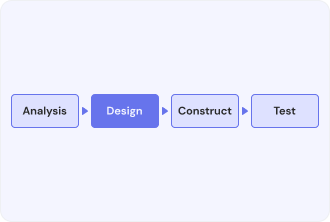Design Phase Definition

The design step in the software development life cycle (SDLC) plays the role of the architectural spine of the whole undertaking. It helps to bridge the gap between thinking and doing, putting abstract ideas into the form of concrete, designated images and models.
It is the phase in the process that determines how the software will look and behave without any line of code written. It requires visual and structural planning; this is the foundation that the development team can work with comfortably.
At its core, the design phase maps out the product’s blueprint, outlining user journeys, functionality flows, data interactions, system interfaces, and screen layouts. This is where form and function must find a harmonious balance.
Outputs created during this stage will be different according to the complexity of the project, though they usually include deliverables prepared by your UK-based outsourcing software partner, such as:
- Low-fidelity layouts and structure
- Mockups
- Prototypes
- Design screens
- System architecture diagrams
- Front-end and back-end interaction specifications
All these artifacts help developers, testers, and stakeholders to stay on the same wavelength, ensuring product alignment with goals and expectations.
Design process in most cases occurs iteratively, at least in Agile or Scrum systems. Designers share sprint to sprint and the client has a chance to review and provide feedback. This step-by-step review cycle lowers risk, minimizes miscommunication, and ensures the project stays on schedule to attain functional and aesthetic definitions.
The design stage can typically be divided into two strongly related fields:
- UI (User Interface) Design
- UX (User Experience) Design
Each has different objectives to achieve, but eventually aims at one common objective, which is the delivery of a comprehensive product.
UX Design: Structuring Experience and Functionality
User experience (UX) design works on the pattern, ease of use and rules guiding a digital product. It covers such areas as the interaction of users with the system and the ability to take them through the system in a natural manner.
The work of a UX designer can be compared to the work of an architect: first, they have to plan the composition of the house in terms of where to put the doors and the windows and how to make one room connected to another without actually committing on the furniture or other colors (UI). The phase of UX, as practiced by top app development firms in the UK, usually begins with:
User research. Interviews, surveys, competitor analysis, and behavioral insights help shape user personas and use cases.
User journey mapping. It is about a visual representation of the interaction of a user with the product from the beginning till the end, identifying various points of pain and opportunity.
Information architecture (IA). Structuring content logically so users can find what they need without frustration.
Wireframes & low-fidelity prototypes. Schematic versions are simple layouts that can be used to quickly find the usability situation.
The target is to make the given product seem natural to operate. An effective UX design removes mental complexity, enhances ease of navigation and makes the user experience rewarding, which inevitably affects customer satisfaction and retention.
In the case of a mobile banking app, the UX design should make sure the process of transferring money is as short as possible, navigation skills between functions are intuitive, and the error report is positive and not exasperating.
Another tendency in modern UX design is relying on accessibility and inclusivity so that interfaces can be used by everyone in terms of their age, ability, and device.
UI Design: Crafting the Visual and Interactive Layer
And when the foundation is built by UX, the design of the User Interface (UI) jumps in to form the visual character of the product. It is at the border of branding, creativity and aesthetics where branding leads into usability UI design. It refers to all visuals that the users observe and click on: buttons, fonts, color, icons, spacing, animation, and reactiveness.
Low-fidelity wireframes created during the UX step are developed into high-fidelity mockups and clickable prototypes by UI designers who generally transform them to resemble the actual product. They are supposed to make sure that the software is both functional and exciting, refined and brand-matching. The most important activities on the UI level are:
- Design systems & style guides. There should be uniformity of visual components that are well-recorded throughout the whole application.
- Prototypes. Interactive prototypes such as those made using Figma or Adobe XD enable the stakeholders to experience the design in play, to identify usability issues on time.
- Responsive design. Layout flows adaptively between different devices and screens in order to present an unparalleled user experience.
Modifications for accessibility. To meet the needs of users who have vision or motor impairments, adjustments have been made to color contrast, font legibility, and input space.
A good UI is not fancy because it looks good. It possesses guidance, very straightforward actions that are emphasized, and thus creates trust utilizing visual clarity and consistency. Even minor animations or microinteractions (such as a ripple on a button tap or a shake on invalid form submission) can help make the product appear handier and interactive.
Working with clients sprint by sprint, UI design becomes an aid to storytelling. Customers no longer have to speculate how the final piece may appear: they have a chance to see it on the screen, screen by screen, making it easier to align feedback and decisions before they hire professional web developers to bring it to life.